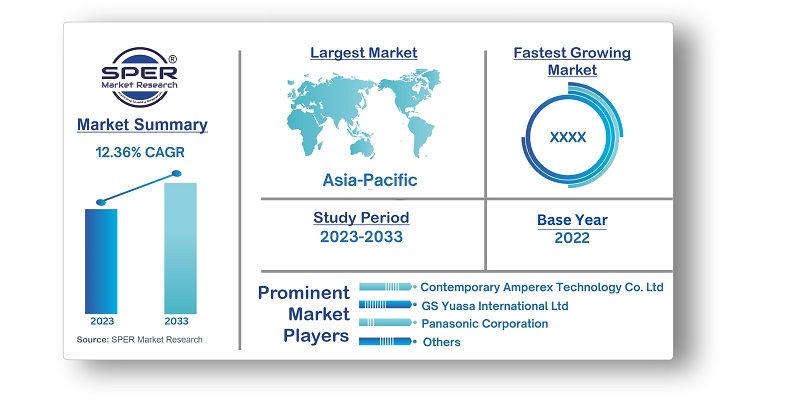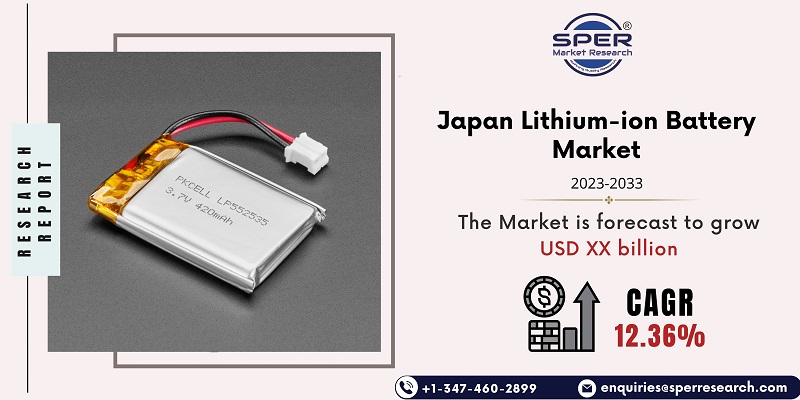
Japan Lithium-ion Battery Market Growth, Size, Trends, Demand, Revenue and Future Outlook
Japan Lithium-ion Battery Market Size- By Application- Regional Outlook, Competitive Strategies and Segment Forecast to 2033
| Published: Jan-2024 | Report ID: POAE2411 | Pages: 1 - 108 | Formats*: |
| Category : Power & Energy | |||
- Tesla announced in August 2021 that it would be constructing an energy storage facility that would be grid-connected and have a capacity of 6,095 kWh, or enough energy to power about 500 homes. By 2022, the project is anticipated to begin.
- APB Corporation, a start-up based in Japan, plans to begin producing lithium-ion batteries made entirely of plastic in April 2021. These goods increase the safety of ability cells, which boosts their use in electric cars. Applications for APB's plastic batteries include EVs, cellphones, and the solar and wind energy industries.


| Report Metric | Details |
| Market size available for years | 2019-2033 |
| Base year considered | 2022 |
| Forecast period | 2023-2033 |
| Segments covered | By Application |
| Regions covered | East Region, West Region, north Region, Central. |
| Companies Covered | B & B Battery Co. Ltd, Contemporary Amperex Technology Co. Ltd, EEMB Battery, Furukawa Battery Co. Ltd, GS Yuasa International Ltd, LG Energy Solution, Lithium Energy Japan, Maxell, Ltd, Panasonic Corporation, Toshiba Corporation, Others |
- Battery Manufacturers
- Automotive Industry
- Energy Storage Solution Providers
- Investors and Financial Institutions
- Government and Regulatory Bodies
- Research and Development Organizations
- Technology Enthusiasts and Innovators
- Environmental Organizations
| By Application: |
|
| By Region: |
|
- Japan Lithium-ion Battery Market Size (FY’2023-FY’2033)
- Overview of Japan Lithium-ion Battery Market
- Segmentation of Japan Lithium-ion Battery Market By Application (Electronic Devices, Automotive, Energy Storage Systems, Others)
- Expansion Analysis of Japan Lithium-ion Battery Market
- Problems and Obstacles in Japan Lithium-ion Battery Market
- Competitive Landscape in the Japan Lithium-ion Battery Market
- Impact of COVID-19 and Demonetization on Japan Lithium-ion Battery Market
- Details on Current Investment in Japan Lithium-ion Battery Market
- Competitive Analysis of Japan Lithium-ion Battery Market
- Prominent Players in the Japan Lithium-ion Battery Market
- SWOT Analysis of Japan Lithium-ion Battery Market
- Japan Lithium-ion Battery Market Future Outlook and Projections (FY’2023-FY’2033)
- Recommendations from Analyst
1.1. Scope of the report1.2. Market segment analysis
2.1. Research data source2.1.1. Secondary Data2.1.2. Primary Data2.1.3. SPER’s internal database2.1.4. Premium insight from KOL’s2.2. Market size estimation2.2.1. Top-down and Bottom-up approach2.3. Data triangulation
4.1. Driver, Restraint, Opportunity and Challenges analysis4.1.1. Drivers4.1.2. Restraints4.1.3. Opportunities4.1.4. Challenges4.2. COVID-19 Impacts of the Japan Lithium-ion Battery Market
5.1. SWOT Analysis5.1.1. Strengths5.1.2. Weaknesses5.1.3. Opportunities5.1.4. Threats5.2. PESTEL Analysis5.2.1. Political Landscape5.2.2. Economic Landscape5.2.3. Social Landscape5.2.4. Technological Landscape5.2.5. Environmental Landscape5.2.6. Legal Landscape5.3. PORTER’s Five Forces5.3.1. Bargaining power of suppliers5.3.2. Bargaining power of buyers5.3.3. Threat of Substitute5.3.4. Threat of new entrant5.3.5. Competitive rivalry5.4. Heat Map Analysis
6.1. Japan Lithium-ion Battery Market Manufacturing Base Distribution, Sales Area, Product Type6.2. Mergers & Acquisitions, Partnerships, Product Launch, and Collaboration in Japan Lithium-ion Battery Market
7.1. Japan Lithium-ion Battery Market Value Share and Forecast, By Application, 2023-20337.2. Electronic Devices7.3. Automotive7.4. Energy Storage Systems7.5. Others
8.1. Japan Lithium-ion Battery Market Size and Market Share
9.1. Japan Lithium-ion Battery Market Size and Market Share By Application (2019-2026)9.2. Japan Lithium-ion Battery Market Size and Market Share By Application (2027-2033)
10.1. Japan Lithium-ion Battery Market Size and Market Share By Region (2019-2026)10.2. Japan Lithium-ion Battery Market Size and Market Share By Region (2027-2033)10.3. Central10.4. East10.5. West10.6. South
11.1. B & B Battery Co. Ltd11.1.1. Company details11.1.2. Financial outlook11.1.3. Product summary11.1.4. Recent developments11.2. Contemporary Amperex Technology Co. Ltd11.2.1. Company details11.2.2. Financial outlook11.2.3. Product summary11.2.4. Recent developments11.3. EEMB Battery11.3.1. Company details11.3.2. Financial outlook11.3.3. Product summary11.3.4. Recent developments11.4. Furukawa Battery Co. Ltd11.4.1. Company details11.4.2. Financial outlook11.4.3. Product summary11.4.4. Recent developments11.5. GS Yuasa International Ltd11.5.1. Company details11.5.2. Financial outlook11.5.3. Product summary11.5.4. Recent developments11.6. LG Energy solution11.6.1. Company details11.6.2. Financial outlook11.6.3. Product summary11.6.4. Recent developments11.7. Lithium Energy Japan11.7.1. Company details11.7.2. Financial outlook11.7.3. Product summary11.7.4. Recent developments11.8. Maxell, Ltd11.8.1. Company details11.8.2. Financial outlook11.8.3. Product summary11.8.4. Recent developments11.9. Panasonic Corporation11.9.1. Company details11.9.2. Financial outlook11.9.3. Product summary11.9.4. Recent developments11.10. Toshiba Corporation.,11.10.1. Company details11.10.2. Financial outlook11.10.3. Product summary11.10.4. Recent developments11.11. Others
SPER Market Research’s methodology uses great emphasis on primary research to ensure that the market intelligence insights are up to date, reliable and accurate. Primary interviews are done with players involved in each phase of a supply chain to analyze the market forecasting. The secondary research method is used to help you fully understand how the future markets and the spending patterns look likes.
The report is based on in-depth qualitative and quantitative analysis of the Product Market. The quantitative analysis involves the application of various projection and sampling techniques. The qualitative analysis involves primary interviews, surveys, and vendor briefings. The data gathered as a result of these processes are validated through experts opinion. Our research methodology entails an ideal mixture of primary and secondary initiatives.



Frequently Asked Questions About This Report
PLACE AN ORDER
Year End Discount
Sample Report
Pre-Purchase Inquiry
NEED CUSTOMIZATION?
Request CustomizationCALL OR EMAIL US
100% Secure Payment






Related Reports
Our Global Clients
Our data-driven insights have influenced the strategy of 200+ reputed companies across the globe.




















